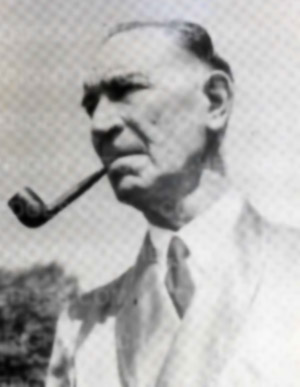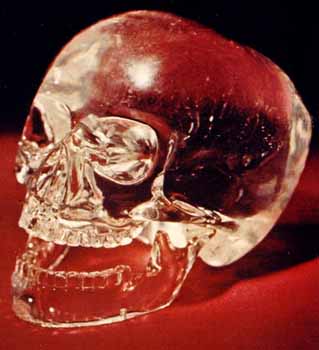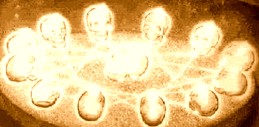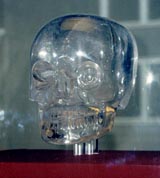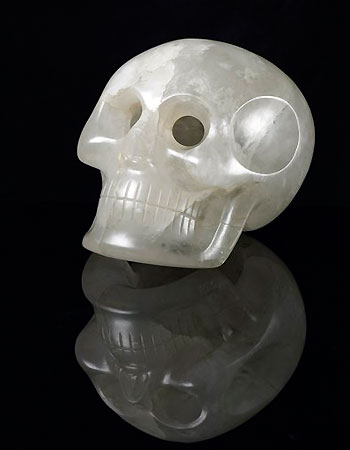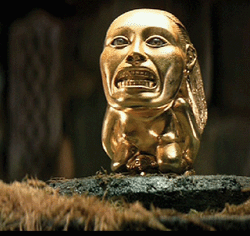|
Enigma of the Crystal Skulls |
|||||
|
..
(This article appeared in Frontier Magazine 1.3 (1995) and has been adapted by Philip Coppens) Excerpt One The most illustrious of the “archaeological skulls”
is the Mitchell-Hedges
skull, an almost perfect copy of a human skull. It
consists of two parts,
namely the skull itself and a separate jawbone, which
thus allows for movement,
as if the head is speaking. The skull was apparently
found in the ruins
of Lubantuum, in Belize in 1927, by Anna
Mitchell-Hedges, on her 17th birthday.
One story has it that Mitchell-Hedges had discovered
the skull some
time before its official discovery, but had hidden it,
so that Anna could
find it on her 17th birthday. Other accounts argue
that Anna did not find
the skull at all… Another account relates that the
local population became
close to hysterical when the skull was shown to them.
Alice Bryant and
Phyllis Glade, in The Message of the Crystal Skull,
report that the local
Mayan people began to dance, while others worshipped
it as a relic. In
no time, an altar was erected on which the skull was
placed. Allegedly
– once again – the local workforce stopped all further
excavations for
a period of three days for feasting. Apparently, the
situation left Mitchell-Hedges
confused, not knowing how to behave and what to do. It
seems that he even
offered the skull as a present to the local people,
provided they returned
to their excavation work, suggesting he did not think
too highly of the
monetary value of the skull and wanted more – perhaps
gold. Allegedly,
they agreed and returned the following day.
In 1970 the Crystal Skull was examined by experts at the Hewlett Packard Crystal laboratories. Their conclusions surprised even themselves. They found that the Crystal Skull had been carved out of an exceptional piece of pure crystal against the grain or structure of the crystal. This should have caused the crystal to shatter. More puzzling still, there were no tool marks to be seen. Not even microscopic ones. Although it is an anthropologically accurate carving of a human skull produced by a scientifically advanced civilization, they admitted that we couldn't make it today and had no idea who had made it and for what purpose. All findings that would have greatly amused Mitchell-Hedges greatly and had him reminding us of his theory. |
|||||
The most widely celebrated and mysterious crystal skull is the Mitchell-Hedges Skull, for at least two reasons. First, it is very similar in form to an actual human skull, even featuring a fitted removable jawbone. Most known crystal skulls are of a more stylized structure, often with unrealistic features and teeth that are simply etched onto a single skull piece. Second, it is impossible to say how the Mitchell-Hedges skull was constructed. From a technical standpoint, it appears to be an impossible object which today's most talented sculptors and engineers would be unable to duplicate. The discovery of the Mitchell-Hedges crystal skull, sometimes referred to as the "Skull of Doom". is a controversial matter, and reads like a sci-fi action adventure film. The skull was made from a single, unusually large block of clear quartz crystal, and measured 5 inches high, 7 inches long, and 5 inches wide, weighing 11 pounds, 7 ounces. It closely corresponds in size to a small human cranium, with near perfect detail, even to rendering the skull without the globular prominence or superciliary ridges, which are characteristics of a female. As the story goes ... One day in 1927, English adventurer, traveler, and writer, F. A. Mitchell-Hedges, who had a talent for telling colorful stories, was clearing debris from atop a ruined temple at the ancient Mayan city of Lubantuum, located in British Honduras, now Belize. His seventeen year old daughter Anna, who had accompanied him, suddenly saw something shimmering in the dust below. Anna found an exquisitely carved and polished skull made of rock crystal, with the jaw piece missing. Three months later, she located the jaw in an excavation about 25 feet from the first site. In 1970, art conservator and restorer Frank Dorland was given permission by the Mitchell-Hedges estate to submit the quartz skull to tests conducted at the Hewlett-Packard Laboratories at Santa Clara, California. From these tests, and from careful studies done by Dorland himself, the skull revealed a whole array of anomalies. When submersed in a benzyl alcohol bath, with a beam of light passing through, it was noted that both the skull and jaw piece had come from the same quartz block. What was astounding to the testers, however, is they found that the skull and jaw had been carved with total disregard to the natural crystal axis in the quartz. In modern crystallography, the first procedure is always to determine the axis, to prevent fracturing and breakage during the subsequent shaping process. Yet, the skull's maker appears to have employed methods by which such concerns were not necessary. The unknown artist also used no metal tools. Dorland was unable to find signs of any tell-tale scratch marks on the crystal, under high-powered microscopic analysis. Indeed, most metals would have been ineffectual, for the crystal has a specific gravity of 2.65, and a Mohs hardness factor of 7. In other words, even a modern penknife cannot make a mark on it. From tiny patterns in the quartz near the carved surfaces, Dorland determined the skull was first meticulously chiseled into a rough form, probably using diamonds. The finer shaping, grinding and polishing, Dorland believes, was done by applying innumerable applications of solutions of water and silicon crystal sand. The big problem is, if these were the processes used, then, as Dorland calculated, it would mean that a total of 300 man-years of continuous labor was spent in making the skull. We must accept this almost unimaginable feat, or admit to the use of some form of lost technology in the skull's creation the likes of which we have no equivalent today. The enigma of the skull, however, does not end with just its making. The zygomatic arches (the bone arch extending along the sides and front of the cranium) are accurately separated from the skull piece, and act as light pipes, using principles similar to modern optics, to channel light from the base of the skull to the eye sockets. The eye sockets in turn are miniature concave lenses that also transfer light from a source below, into the upper cranium. Finally, in the interior of the skull is a ribbon prism and tiny light tunnels, by which objects held beneath the skull are magnified and brightened. Richard Garvin, who authored a book about the crystal skull, believes the skull was designed to be placed over an upward shining beam. The result, with the various light transfers and prismatic effects, would illuminate the entire skull and cause the sockets to become glowing eyes. Dorland performed experiments using this technique, and reported the skull 'lights up like it was on fire.' Still another finding about the crystal skull reveals knowledge of weights and fulcrum points. The jaw piece fits precisely onto the skull by two polished sockets, which allow the jaw to move up and down. The skull itself can be balanced exactly where two tiny holes are drilled on each side of its base, which probably once held suspending supports. So perfect is the balance at these points that the slightest breeze causes the skull to nod back and forth, the jaw opening and closing as counter-weight. The visual effect is that of a living skull, talking and articulating. The question, of course, is what purpose did this serve? Was the skull only designed by its artist as a clever toy or conversation piece, or, as Dorland believes, was the talking skull meant to be used as an oracular device, through strange phenomena associated with the crystal skull, that defy logical explanation. Observers have reported that, for unknown reasons, the skull will change color. Sometimes the frontal cranium clouds up, looking like white cotton, while at other times it turns perfectly clear, as if the space within disappears into an empty void. Over a period from 5 to 6 minutes, a dark spot often begins forming on the right side and slowly blackens the entire skull, then recedes and disappears as mysteriously as it came. Other observers have seen strange scenes reflected in the eye sockets, scenes of buildings and other objects, even though the skull is resting against a black background. Still others have heard ringing noises emanating from within, and at least on one occasion, a distinct glow from no known light source surrounded the skull like an aura for up to six minutes. The sum total of the skull appears to take in all five physical senses of the brain. It changes color and light, it emits odors, it creates sound, it gives off sensations of heat and cold to those who touch it, even though the crystal has always remained at a physical temperature of 70 degrees F under all conditions, and has even produced sensations of thirst and sometimes of taste in a few cases. Dorland is of the opinion that what is happening in all this phenomena is that the 'crystal stimulates an unknown part of the brain, opening a psychic door to the absolute.' He observes, 'crystals continuously put out electric like radio waves. Since the brain does the same thing, they naturally interact.' He has found, too, that periodic happenings in the crystal skull are due to the positions of the sun, moon and planets in the sky. Researcher Marianne Zezelic agrees that the skull was primarily used to stimulate and amplify the psychic abilities in its handlers. She observes. "Crystal serves as an accumulator of terrestrial magnetism. By gazing at the crystal, the eyes set up a harmonic relation stimulating the magnetism collected in that portion of the brain known as the cerebellum." The cerebellum therefore becomes a reservoir of magnetism which influences the quality of the magnetic outflow through the eyes, thus setting up a continuous flow of magnetism between gazer and crystal. The amount of energy entering the brain eventually increases to such a proportion as to affect the poles of the brain, a region extending just above the eyes, contributing to psychic phenomena.' Going a step further, Tom Bearden, an expert in the field of psychotronic studies, believes that, in the hands of a skilled mediator and mental focaliser, the crystal skull also served not only as a vehicle to transform life field energy into electromagnetic energy and other physical effects, but also aided in healing, by the altering of its crystalline resonance to match that of a patient's mind and body frequencies, and affecting curing energies on the skull that would manifest in the patient's auric field. The skull should thus be used as an amplifier and a transmitter of psychic and earth energy forces. When looking at the sum total of skill and knowledge incorporated in the Mitchell-Hedges skull, modern science is stumped as to how to explain it. Author Garvin summarized the findings in these words: 'It is virtually impossible today -- in the time when men have climbed mountains on the moon -- to duplicate this achievement. The lenses, light pipes, and prisms alone display a technical competence that the human race only achieved recently. In fact, there is no one on the globe today who could attempt to duplicate the carving. It would not be a question of skill, patience and time. It would simply be impossible. By Rob McConnell of the X-Zone Radio Show in Ontario, Canada Editors Note: While it does add a dramatic touch to any story, making a statement that "It would simply be impossible." in today's world is simply not true and misleads the investigation. Quartz being a hardness of 7 on the Moh's scale means that high level polishing could be done using corundum {hardness 9 This is ruby or sapphire and was available in antiquity}, carborundum and diamond powders. A totally flawless cut can be done by laser cutting, a practice common in major gem cutting houses today. Idar Oberstein in Germany has been carving and polishing fine quartz and agate for over a hundreds years and the Egyptians and Romans has similar skills. This makes documenting the origin of the skull very important before drawing conclusions. One account gives the hardness as 9. If that is true it would mean the skull would have to be clear topaz, a crystal that commonly comes in large clear pieces and is mined in Brazil. |
|||||
|
The enigma of the skull, however, does not end with just its making. The zygomatic arches (the bone arch extending along the sides and front of the cranium) are accurately separated from the skull piece, and act as light pipes, using principles similar to modern optics, to channel light from the base of the skull to the eye sockets. The eye sockets in turn are miniature concave lenses that also transfer light from a source below, into the upper cranium. Finally, in the interior of the skull is a ribbon prism and tiny light tunnels, by which objects held beneath the skull are magnified and brightened. - Source The optical effects were the result of how the skull was carved, which also enabled Dorland to realize how precise the workmanship had been. He observed that there was a type of “layering” on top of the skull, which made the skull behave like an amplifying glass. The back of the skull channeled the light through the eye sockets at the front of the eye. If no one would have been able to see what was happening behind the skull, anyone in front of the skull would perceive a spectacular series of images occurring from the front of the skull, which would appear to originate from within the skull. - Source
|
|||||
...A MALP probe sent to P7X-377 discovers a gigantic pyramid on the apparently deserted planet -- a pyramid over 1,000 meters high! Inside, down a long stone walkway and through high levels of neutrino radiation, sits a crystal skull atop a stone platform. ...The artifact -- carved from a single piece of crystal -- appears to be identical to a skull that Daniel Jackson's grandfather, Nicholas Ballard, discovered in Belize, Central American 1971. SG-1 visits the planet to investigate the object, although the high levels of radiation within the pyramid will limit their trip to just a few minutes. ...But when Daniel approaches the object, a circle of energy begins to swirl around him. Radiation levels begin to increase exponentially. Teal'c fires a zat gun at the object, and Daniel is thrown backward to the stone floor. But he is no longer visible to his teammates -- he has disappeared. With Carter unconscious from the radiation, the three flee back to the Stargate, leaving Daniel invisible and unconscious. ...What Daniel did not tell them was that his grandfather had a strange experience with the crystal skull from Belize. He said that he was transported by the skull to a gigantic cavern, where he met "giant aliens" who said to him, "The enemy of my enemy is my friend" (in ancient Mayan). Nick was ridiculed by the scientific community, and the aging man is now in a mental institution. ...Daniel is reunited with the others, who can now see him. The giant alien whom Nick had encountered decades ago appears to them -- an imposing, ethereal being named Quetlezcoatl. "The enemy of my enemy is my friend," he says. Daniel realizes that the aliens are enemies of the Goa'uld -- Teal'c was not transported because of his larval Goa'uld symbiote. "We are enemies of the Goa'uld!" Daniel exclaims. Coincidence? |
|||||
We will cover this topic in the Sacred Geometry section of our website, but as this item came up during a search for crystal skulls, it is worthy of mention here. When we have more direct info on the relation of the skulls we will add it here. |
|||||
* The Mayans of Mexico. These
skulls are mentioned
in the Popol Vul.
More Research Required |
|||||
There are a number of different theories that have been given as to explain how these ancient skulls may have been manufactured; some of which are quite fantastic in their scope. It has been difficult to trace the true history about these objects as far as where the skulls may have originated from or which parts of the world they have traveled through. Attempts have been made by various groups to work with trained sensitives in the presence of a crystal skull and record the impressions that they psychically receive. However this method does not always guarantee success as the historical information channeled by these psychics does not always agree and even can be conflicting at times. "OLD" - a crystal skull that was created between 100 years ago to about 1000 years ago. A number of these types of skulls have been discovered within or near ancient ruins in Mexico or Central America. In general, the appearance of these crystal skulls are somewhat crude in form and upon a close examination of the surface of an "Old" crystal skull, there are usually observed some type of tool marks left by its carver, similar to what can be detected with the newly made crystal skulls. "NEW or CONTEMPORARY" - These are crystal skulls that are being manufactured by modern carvers. There are thousands upon thousands of such skulls in existence today. Since the middle part of the 1990's, there has been an explosion in the interest about the crystal skulls. There are quite a few people now, in all parts of our world, who have acquired their own personal skull to work with and use. The contemporary crystal skulls come in all shapes and sizes and are being primarily done by carvers in Brazil and China. These skulls can even be found for sale upon E-Bay. (The above three classifications of crystal skulls discussed were originated by the Society of Crystal Skulls International, in an attempt to distinguish the different type of skulls that exist in the world.) Most of us are familiar with quartz crystals as this gemstone serves as a key component within all of our modern-day electronics; the devices that we use each and every day. There are many people today who work with their personal crystals in order to re-energize themselves, for healing (physical or emotional problems) or even to assist them in their development of their inner or spiritual gifts. However, when one begins to work with a quartz crystal that is in the shape of a human-like skull - other strange phenomena begin to occur around them. We have received numerous reports from people all over the world having some very special experiences connected to the crystal skulls. |
|||||
|
British Crystal Skull - London's
Museum of Mankind
since
1898
Paris Crystal Skull - Trocadero
Museum of Paris
Further examples of primitively sculpted skulls are a couple called the Mayan Crystal Skull and the Amethyst Skull. They were discovered in the early 1900s in Guatemala and Mexico, respectively, and were brought to the U.S. by a Mayan priest. The Amethyst Skull is made of purple quartz and the Mayan skull is clear, but the two are otherwise very alike. Like the Mitchell-Hedges skull, both of them were studied at Hewlett-Packard, and they too were found to be inexplicably cut against the axis of the crystal.
Texas Crystal Skull (Max)
|
|||||
|
..
Ancient
Mexico, Hollywood and
the French Connection
Hollywood often entertains us by playing to our fantasies. The wildly entertaining Indiana Jones movies give us Hollywood’s version of a university professor and archaeologist, not to mention its idea of scientific inquiry. Ah, academia, all adventure and glamour with a bit of danger and heroics thrown in. Dr. Jones has every girl and boy’s dream job; “Oh, I always wanted to be an archaeologist!” Interestingly, the objects that Indy risks his life for in these films are no more real than the “archaeology” he conducts. In his first adventure, Dr. Jones is in hot pursuit of an extremely valuable, rare and exotic golden idol. The goddess’s image, which he deftly snatches from an altar, letting loose an enormous boulder that nearly crushes our hero, is of a woman in the act of giving birth. The latest issue of the saga is
entitled Indiana Jones
and the Kingdom of the Crystal Skull, and the
crystal skulls in this movie
are alien skulls, outer space aliens, not aliens
who’ve crossed our borders,
despite the fact that crystal skulls are usually
said to be from ancient
Mexico.
Dumbarton Oaks Museum - Tlazolteotl Aztec, 1200-1520 A.D. Aplite PC.B.071 Description
on the musem display:
The goddess giving birth and crystal skulls share the distinction of being highly suspect as Aztec, Mixtec, or even pre-Columbian (Walsh 1997; 2006; 2008a, b; Pasztory 2002). Indiana Jones is not the only person, or even archaeologist, real or imagined, whom these two types of artifacts have fooled, however. The greenstone Tlazolteotl has been considered a masterpiece of pre-Columbian art since around the turn of the 20th century. A French mineralogist, Augustin Damour, purchased it in 1883, from a Chinese dealer, with the advice of a Parisian antiquarian named Eugene Boban. Sixty years later Robert Woods Bliss, who had an eye for gold and jade artifacts from Mexico, bought it from the estate of another art dealer. My own study of this sculpture, which is being published by the Journal of the Society of Americanists, elucidates its history, iconography, and technology and indicates that it is a 19th-century invention (2008). Carvings of human skulls in quartz crystal are highly collectable objects. They seem to reflect an enduring love of our own image, as well as of the morbid and exotic, and while usually attributed to pre-Columbian Mexican cultures, not a single one in museum collections comes from a documented excavation, and they have little stylistic or technical relationship with any actual pre-Columbian carvings of skulls. |
|||||
| FAIR USE NOTICE: This page contains copyrighted material the use of which has not been specifically authorized by the copyright owner. Pegasus Research Consortium distributes this material without profit to those who have expressed a prior interest in receiving the included information for research and educational purposes. We believe this constitutes a fair use of any such copyrighted material as provided for in 17 U.S.C § 107. If you wish to use copyrighted material from this site for purposes of your own that go beyond fair use, you must obtain permission from the copyright owner. | |||||
| ~ MENU ~ |
